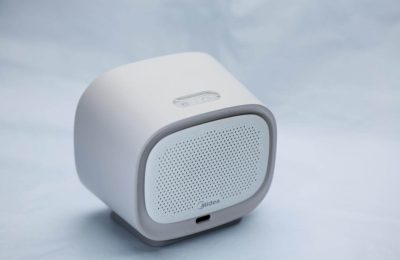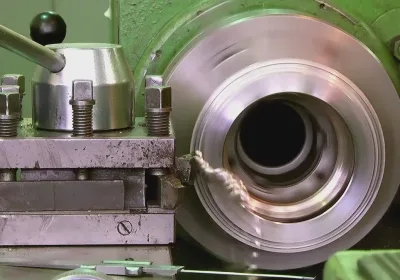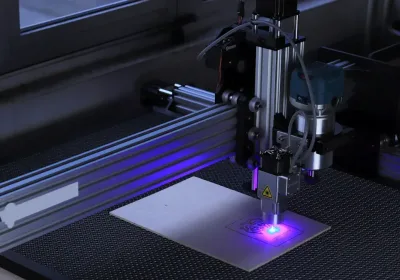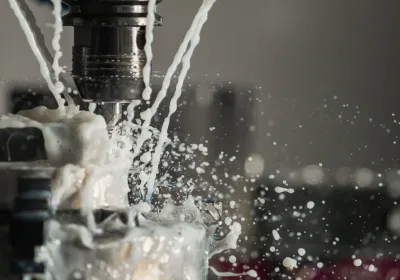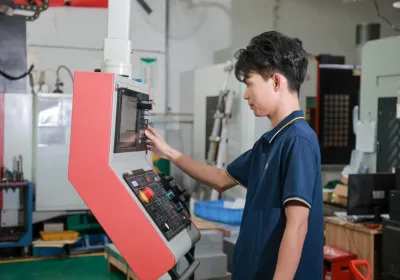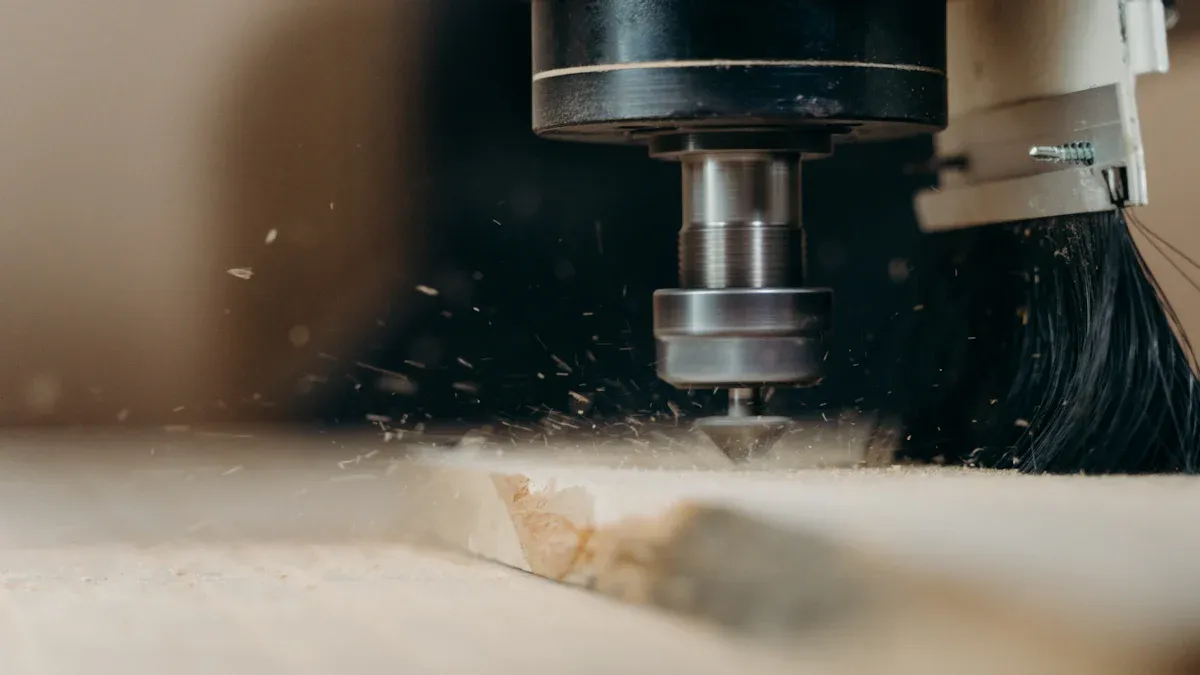
When you think of making products, accuracy and speed matter most. CNC machine routers have changed how businesses work to meet these goals. These machines can do hard tasks automatically, giving steady quality and faster production. For example, CNC routers with auto-calibration and nesting software use less material and avoid mistakes. This saves money and keeps quality high.
Think about this: in 2023, metalworking made up 39.6% of the global CNC router market earnings. This shows how these machines help industries work better and earn more. Whether you cut soft metals or make custom furniture, a CNC router helps by simplifying tasks and increasing production.
Key Takeaways
CNC routers do cutting jobs faster and more accurately. This makes better products and uses less material.
Picking the right CNC router depends on what you need. Look at things like power and automation to work better.
Buying a CNC router can save money over time. Many companies cut costs by 10-25% and work faster.
Taking care of CNC routers is very important. Cleaning and updating them stops problems and keeps them working well.
Knowing the costs of CNC routers helps you choose wisely. Plan for setup, training, and software in your budget.
Overview of CNC Machine Routers
What Are CNC Machine Routers?
A CNC machine router is a cutting tool controlled by a computer. It works on materials like wood, metal, plastic, and composites. Unlike hand tools, it uses software to make exact cuts and shapes. Think of it as a smart tool that does hard jobs automatically. It ensures every cut is accurate and the same every time. CNC routers belong to a group of machines, including CNC milling and cutting machines. These tools are vital for industries needing precise and fast work.
The demand for CNC routers has grown a lot over time. In 2024, their market value was about USD 881.94 million. By 2033, it’s expected to reach USD 1,300.52 million. This rise shows how businesses want more automation and custom-made products.
Key Features of CNC Routers
CNC routers have features that improve their speed and accuracy. Some top features include:
Precision Fastening: Makes parts fit perfectly, reducing mistakes.
Automated Production: Speeds up work and lowers labor costs.
Material Versatility: Works with many materials without losing quality.
Advanced Cutting Techniques: Handles tricky designs like slots and inlays.
These features make CNC routers important for high-quality manufacturing. For instance, their positioning accuracy is between 0.03 and 0.05 mm. Repeated positioning accuracy is about 0.03 mm. This ensures every cut matches your needs exactly.
Common Applications in Manufacturing
CNC routers are used in many industries. In woodworking, they make furniture, cabinets, and decorations, covering 40% of the market. Metalworking, which is 30% of the market, uses them for tasks like fastening and threading. They are also key in automotive and aerospace industries, where precision is crucial for making parts.
You’ll also see CNC routers in industries needing detailed designs, like jewelry and signage. Their ability to work with different materials and give consistent results makes them essential for modern manufacturing.
Comparison of Top CNC Router Models
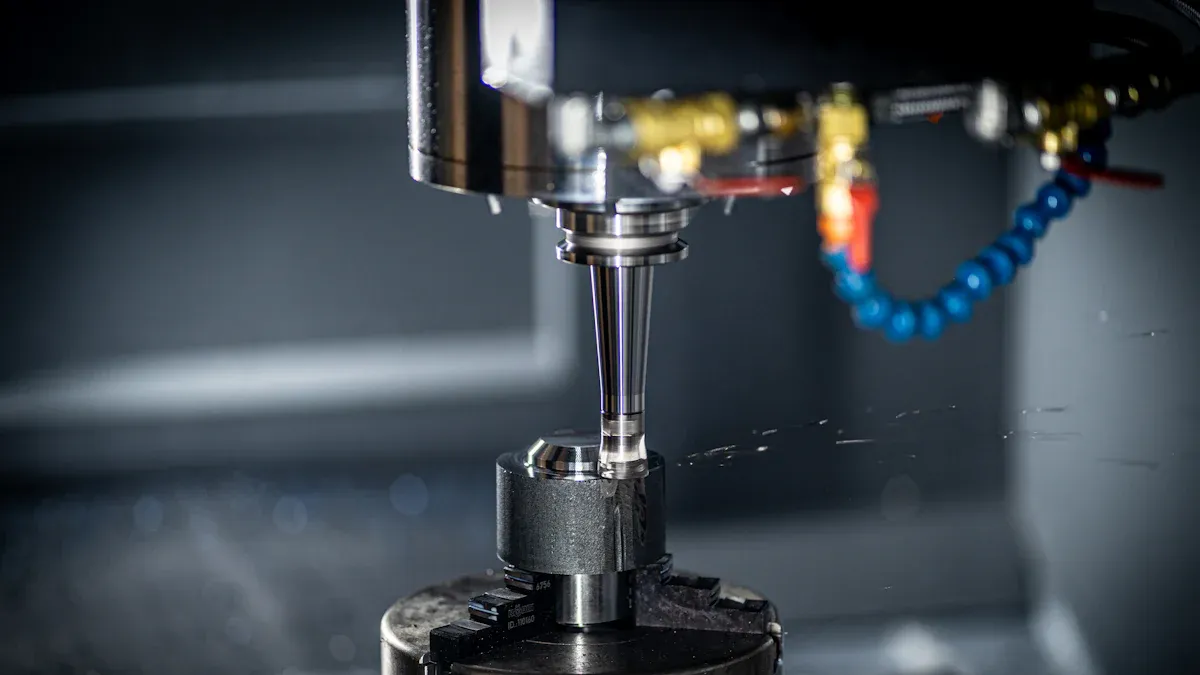
Tormach CNC Routers
Tormach routers are budget-friendly but still high-quality machines. They are great for small businesses and hobbyists. You can upgrade and customize them to fit your needs. For example, the 1500MX model has a strong epoxy granite frame. This frame reduces vibrations, improves finishes, and helps tools last longer.
The PathPilot Control System makes Tormach routers easy to use. It’s simple for beginners and gives real-time feedback. You can add upgrades like better spindles, tools, and accessories. These features make Tormach routers flexible for many tasks. They work well with wood, metal, and other materials.
Haas CNC Routers
Haas routers are strong and dependable machines. They are perfect for jobs needing precision and heavy-duty work. Industries like automotive and aerospace often use them because they handle tough tasks.
A big advantage of Haas routers is their automation features. For example, the Automatic Tool Changer (ATC) swaps tools quickly. This saves time and keeps work moving smoothly. Haas offers many models, so you can pick one that fits your needs. They work well for different materials and production sizes.
Mazak CNC Routers
Mazak routers use advanced technology and are very productive. They have factories worldwide, including one in Kentucky making 135 machines monthly. Their smart factories use robots and AI for better efficiency and accuracy.
If you need very precise work, check out the VC-500A/5X model. It’s great for making detailed parts, like those for medical devices. This router is accurate and reliable for tricky tasks. Mazak routers are also durable and have advanced features, making them good for long-term use in tough jobs.
AXYZ CNC Routers
AXYZ CNC routers are known for being flexible and customizable. These machines work well in industries like woodworking, signage, and plastics. Whether you need small or large production, AXYZ offers models for different tasks.
A standout feature of AXYZ routers is their modular design. You can add options like extra cutting heads, automatic tool changers, or vacuum systems. This lets you adjust the machine to fit your needs. For example, the Trident Series combines routing, knife cutting, and creasing. This makes it perfect for jobs needing precision and multiple tools.
Another great thing about AXYZ routers is their strong build. They are made to handle heavy work without losing performance. Their high-speed spindles, reaching up to 24,000 RPM, make smooth and accurate cuts. These routers work well with materials like wood, acrylic, and aluminum.
If you want better efficiency, AXYZ routers have advanced software. The A2MC controller gives real-time monitoring and control. This helps reduce downtime and ensures precise cuts every time. With these features, AXYZ routers are a smart choice for businesses wanting quality and productivity.
Tip: Think about the materials and production sizes you’ll use. This helps you pick the right AXYZ router model for your needs.
ROI Analysis for CNC Routers
Initial Costs and Financing Options
When buying a CNC router, knowing the costs is important. Prices depend on the type of router. Mid-range routers cost $10,000 to $50,000. High-end industrial routers can cost over $150,000. You also need to pay for setup, training, and software. For example:
Type of CNC Router | Price Range |
|---|---|
Mid-range CNC routers | $10,000 - $50,000 |
High-end industrial routers | $50,000 - over $150,000 |
Additional Costs | Description |
|---|---|
Installation and Setup | Prepping the shop and calibrating the machine. |
Training | Teaching operators how to use the router. |
Software | Paying for design and control software. |
Financing can help with these costs. Many companies offer payment plans or leases. This spreads out payments and makes routers affordable. Planning your budget and using financing options can help you get the right router for your needs.
Operating Costs and Maintenance
Running a CNC router has ongoing costs. These include electricity, replacing tools, and regular maintenance. Good-quality parts last longer and save money. For example, routers with strong spindles need fewer repairs and work better over time.
Maintenance is very important. Cleaning, oiling, and updating software keep the router working well. Skipping maintenance can cause breakdowns and slow down production. Choosing a durable router reduces repairs and saves money in the long run.
Productivity and Efficiency Gains
CNC routers improve how fast and well businesses work. Many companies see a 10% boost in equipment performance. Costs drop by 15-25% because of less waste and automation. Downtime also decreases by 40%, keeping production steady.
These benefits come from the router’s precision and advanced features. Tools like automatic changers and real-time monitoring make cutting easier. Adding a CNC router to your business speeds up work, improves quality, and increases profits.
Tip: Pick routers with strong automation and durability. These features save money and improve efficiency, giving you better long-term value.
Case Studies: Real-Life ROI Examples
Looking at how CNC routers work in real life can show their value. Below are two examples of companies that succeeded by using CNC routers.
Example 1: Furniture Company Increases Efficiency
A furniture company had trouble keeping up with orders. Their manual work caused delays and uneven product quality. They bought a mid-range CNC router to fix these issues.
Cost: $45,000 for the router, software, and training.
Improvements:
Production time cut by 30%.
Material waste lowered by 20%.
Labor costs dropped by 15% with automation.
In two years, they earned back their investment. The CNC router helped them take bigger orders and make more products. This shows how the right machine can save money and boost efficiency.
Note: If you’re in a similar business, think about how automation can improve your work and profits.
Example 2: Metal Shop Gains Precision and Grows
A small metal shop made custom car parts but had problems with accuracy and scaling up. They bought a high-end CNC router to solve these challenges.
Cost: $120,000, including setup and software.
Improvements:
Accuracy improved to 0.03 mm, meeting strict standards.
Production doubled, allowing them to take bigger jobs.
Downtime cut by 40% thanks to the router’s reliability.
They recovered their costs in 18 months. The CNC router improved their quality and helped them grow. This example shows how advanced tools can bring big rewards, especially for precise work.
Tip: When choosing a CNC router, match its features to your goals. Spending more upfront can lead to better results later.
Key Takeaways from These Examples
Both stories show how CNC routers can change your business. Whether you want to save money, improve quality, or grow, these machines can help. By picking the right router for your needs, you can get great results and set your business up for success.
Key Considerations for Choosing a CNC Router

Material Compatibility and Cutting Needs
When picking a CNC router, think about the materials you’ll use. Different routers work better with certain materials like wood, metal, or plastic. For example, cutting hard materials like aluminum needs a strong spindle and advanced drive system. Woodworking routers focus on speed and accuracy for softer materials.
Here’s a simple look at specs for material compatibility:
Specification | Details |
|---|---|
Spindle Power | 9.0KW ATC Spindle with 24000RPM, ISO30, ER32 |
Drive System | Helical Rack and Pinion for X and Y-Axis, High precision ball screw for Z-axis |
Max. Working Speed | 45000/min |
Compatible Software | Type3, ArtcCAM, AlphCAM, Vectric, and more |
Tip: Match the router’s strength and cutting ability to your materials. This keeps the machine working well and avoids damage.
Production Volume and Scalability
Think about how much you need to make and future growth. High-volume jobs need a CNC router that stays fast and accurate. Advanced machines have tools like automatic changers and monitoring systems to improve efficiency.
Here are some numbers for high-volume production:
Metric | Value |
|---|---|
Increase in Per-Operator Production | |
Cost Reduction | 40-60% |
Reduction in Floor Space Requirements | 50-70% |
Reduction in Material Waste | 15-20% |
ROI | 12-24 Months |
Note: Spending more on a scalable router now can help your business grow later.
Precision and Accuracy Requirements
Precision is super important for industries like aerospace and medical. A CNC router must meet strict rules to make perfect parts. Look for routers that follow standards like ISO 17025 for accuracy.
To check a router’s precision, follow these steps:
Test the machine with sample programs.
Measure parts using tools like lasers.
Compare results to industry rules.
Write down calibration details.
Track performance with charts over time.
Tip: Keep the router clean and calibrated to stay accurate and reliable.
Budget and Long-Term Value
Picking a CNC router means thinking about cost and future benefits. These machines cost a lot upfront but save money over time.
Initial Investment
CNC routers have different prices based on their type and features. Basic models cost about $30,000, while big industrial ones can go over $500,000. The price includes the machine, setup, and training. For example, a mid-range router might be $50,000, but extras like software and installation add more costs.
Operating Costs
Running a CNC router costs money over time. You’ll pay for electricity, replacing tools, and regular maintenance. Stronger machines cost less to run because they break down less often. Cleaning and updating software keep the machine working well and cutting accurately.
Long-Term Value
Buying a CNC router can be worth it in the long run. Using the machine a lot lowers the cost per item made. Good-quality machines stay reliable, reduce downtime, and boost productivity. Adding new technology costs extra but helps the machine last longer and stay useful.
Tip: Choose machines with strong builds and smart features. They save money and keep cuts accurate for years.
Key Considerations
Initial Costs: Basic models start at $30,000; big ones cost over $500,000.
Operating Expenses: Include power, tool changes, and upkeep.
Maintenance: Regular care keeps the machine working and avoids big repairs.
Technology Upgrades: Make the machine last longer and work better.
By looking at both the cost and long-term value, you can pick a CNC router that fits your business needs.
Picking the right CNC router can improve your manufacturing work. Knowing its features and benefits helps you choose wisely. In 2023, the CNC router market was worth $66.74 billion. It’s growing fast at 10.3% each year. These machines bring big advantages like automation, accuracy, and lower labor costs. Matching the router to your business needs gives the best results.
Here’s how to decide:
Think about the materials you’ll use and how much you’ll make.
Look for smart features like IoT and AI for future upgrades.
Compare upfront costs with long-term savings and growth potential.
By focusing on these points, you can pick a router that boosts your business and lasts for years.
FAQ
How long does a CNC router last?
A CNC router can last 10 to 15 years. Its lifespan depends on how well it’s made and cared for. Cleaning, oiling, and updating software help it last longer.
Tip: Stick to the maker’s care guide to keep your router working longer.
Can CNC routers cut different materials?
Yes, CNC routers can cut wood, metal, plastic, and more. To get the best results, match the router’s cutting tools and spindle power to the material.
Note: Always check the router’s specs to make sure it works with your materials.
How do I pick the best CNC router for my needs?
Think about how much you’ll make, the materials you’ll use, and how exact your cuts need to be. Look at the machine’s features, how it can grow with your business, and its long-term value. Compare costs with what you’ll earn back.
Emoji Reminder: 🛠️ Plan for upgrades so your router stays useful as your business grows.
Are CNC routers hard to use?
Most CNC routers are easy to use and have simple software. Beginners can learn quickly. Advanced features might need extra training, which many companies offer.
Tip: Start with easy projects to learn before trying harder designs.
Why should I use a CNC router?
CNC routers make precise cuts, waste less material, and work faster. They also save money by needing fewer workers. These benefits help businesses work better and earn more.
Emoji Insight: 💡 Automation helps businesses stay ahead in manufacturing.
 LKprototype
LKprototype

